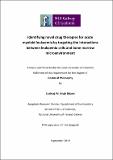| dc.description.abstract | Acute myeloid leukaemia (AML) is a malignancy caused by a block in differentiation in which
aberrant leukemic stem cells drive the production of undifferentiated or partially differentiated
leukemic blast cell clones. Between 10-40% of patients, however, have refractory disease or
undergo relapse. The impact of the bone marrow microenvironment (BMM) is increasingly
recognised as a reason for this. Hence, this thesis is aimed at understanding the interactions
between leukemic cells and the BMM and to devise a therapeutic strategy to target these
interactions. We have developed a functional, drug testing system that can incorporate the
impact of BMM while rapidly and faithfully predicting the clinical response of the patient to
cytarabine+daunorubicin (AraC+Dnr) therapy. We have developed and characterised a
layered co-culture system consisting of primary AML blasts with immortalised bone marrow
stromal cells (BMSCs). This BMSC-AML co-culture can predict the clinical response of
AraC+Dnr therapy with very high accuracy [area under the curve (AUC=0.94)]. The advantage
of this model over more complex pre-clinical AML models is its suitability to be developed into
a laboratory diagnostic tool, which could greatly advance the clinical decision on treatment
choice. Having established the model that mimics the BMM, we have studied its role in
protecting the AML cells against cytotoxic agents such as BH3-mimetics, cytarabine and
daunorubicin. We found that BMSCs induce Mcl-1 expression over Bcl-2 and/or Bcl-XL in AML
cells and that inhibition of Mcl-1 with a small-molecule inhibitor, A1210477, or through
repression of its expression with the cell division cycle-7 kinase/ cyclin dependent kinase 9
(CDC7/CDK9) dual-inhibitor, PHA-767491, restores sensitivity to chemotherapeutics.
Importantly, the CD34+/CD38− leukemic stem cell-encompassing population was equally
sensitive to this combination. These results highlight the potential of Mcl-1-repression to revert
BMM-mediated drug resistance thus preventing disease relapse and ultimately improving
patient survival. Next, we investigated the mechanism through which the BMM protects the
FLT3-ITD mutated AML cells against tyrosine kinase inhibitors (TKIs). We found that FLT3-
ITD cells do not depend on intrinsic, FLT3-driven survival signalling pathways in BMM. We
also observed that exposure of BMSCs to a mild, proteostatic stress revert its ability to protect
AML cells against chemotherapeutics. Importantly, we also found that proteostatic stressconditioned
BMSCs themselves trigger an anti-leukemic effect, which is mediated through
secreted lipids or non-protein moieties. In summary, the results presented in this thesis
illustrate the role of microenvironment interactions in providing chemoresistance to
malignantly transformed cells. We have also presented strategies to target these interactions
for effective and novel therapies that could improve patient outcome. | en_IE |


